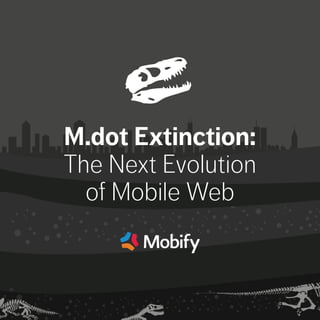M Dot Extinction: The Next Evolution of Mobile Web
The technology world is facing an extinction – m.dot sites are slowly but surely dying out, and for good reason. A survey of the Internet Retailer 500 found that m.dot sites for ecommerce dropped from 79% in 2013 to 59% in 2014, and the trend continues. While numbers still need to be confirmed for this past year, m.dot sites were expected to lose 50% share in 2015. Unlike the dinosaur extinction 65 million years ago, for which the reasons are still widely debated, m.dots are an outdated technology and the reasons for their demise are clear. While m.dots were a huge improvement to serving the desktop site to mobile shoppers, they have failed to evolve with customers’ rising expectations and advancements in technology. Download our M.dot Extinction Storybook to learn the 5 reasons that m.dot sites are disappearing.
Related slideshows

More Related Content
What's hot
What's hot (20)
Viewers also liked
Viewers also liked (20)
Similar to M Dot Extinction: The Next Evolution of Mobile Web
Similar to M Dot Extinction: The Next Evolution of Mobile Web (20)
More from Mobify
More from Mobify (6)
Recently uploaded
Recently uploaded (6)
M Dot Extinction: The Next Evolution of Mobile Web
- 1. M.dot Extinction: The Next Evolution of Mobile Web
- 2. Since the dinosaurs died out 65 million years ago, the cause of the extinction has been speculated and debated. While there are many theories, we still don’t know the definitive reason for the extinction. There are a wide range of theories including climate change, volcanism, sifting continents, an extraterrestrial impact - as well as some more far-fetched ideas like decimation by aliens, dinosaur “wars,” and “paläoweltschmertz”(the idea that dinosaurs just got tired and went extinct).
- 3. oday we are facing an extinction in the technology world - m.dots are dying out - and it’s in the retailer’s best interests. A survey of the Internet Retailer 500 found that m.dot sites for ecommerce dropped from 79% in 2013 to 59% in 2014, and the trend continues. While numbers still need to be confirmed for this past year, m.dot sites were expected to lose 50% s hare in 2015. T
- 4. Unlike the dinosaurs, the cause of this extinction won’t be a mystery. M.dots are an outdated technology with many limitations. When the need for mobile websites emerged, retailers created separate m.dot sites to create a better user experience for customers on mobile devices. While this was a huge improvement to serving the desktop site to mobile shoppers, m.dots have failed to evolve with customers’ rising expectations and advancements in technology. As a result, they’re disappearing from the online world - here are the 5 causes of the m.dot extinction.
- 5. Poor SEO The nature of an m.dot site results in poor SEO. Since m.dot sites are a separate entity with duplicate content, they have the more SEO compliance issues than any other mobile web solution. Google doesn’t like redirects and it penalizes page rankings unless every page and linkable asset is meta tagged with rel=canonical tags that point to which link is the original, desktop or mobile. The effort to implement and maintain this tag strategy is often under resourced or not undertaken at all by retailers leading to poor search engine visibility, lower traffic, and less conversions.
- 6. Slow Performance M.dot sites have a slower initial load time due to the redirect, this doesn’t allow for perfectly live content as the requests need to go back and forth between an intermediary server. Today’s customers expect speedy performance and won’t have the patience to wait for a slow m.dot site to load - 40% of consumers will abandon a website that takes more than 3 seconds to load.
- 7. Social Sharing Issues Two separate URLs also leads to issues with social sharing. If a potential customer on their desktop clicks a link which a friend shared from a mobile device, they will encounter a tiny m.dot site on their large deskop screen. This poor user experience could result in a lost opportunity to create a loyal customer - wrongly executed redirections cost enterprise retailers $34,000 per month on average.
- 8. Multiple Screen Sizes M.dot sites are optimized for a specific screen size, but mobile devices today have a wide range of screen sizes. A layout that is optimized for the screen size of an iPhone 5, may not be the optimal layout for the screen size of an Android Galaxy S6. This issue becomes even more prominent when looking at tablets. A good mobile web solution should be scalable and customizable to optimize the site across all devices and screen sizes.
- 9. Maintenance Challenges A m.dot website has a completely seperate codebase from the desktop site, which means you need to spend the time and resources to manage two websites. Retailers often don’t have the resources to maintain both sites, resulting in content that is outdated or inconsistent across sites.
- 10. Just as life evolved and flourished after the extinction of dinosaurs, next- generation mobile web solutions have emerged to address the limitations associated with m.dot websites. Mobify’s modern adaptive design approach uses a single tag to modify the desktop content to deliver mobile-optimized experiences across devices and screen sizes. The single URL ensures optimal SEO, effective social sharing, and zero redirects. Maintenance is also made easy as any content updates to the desktop version automatically appear in the mobile version of the website. Contact Mobify today to learn more about our modern adaptive design approach to mobile web, visit www.mobify.com or contact us via hello@ mobify.com or 1-866-502-5880.
